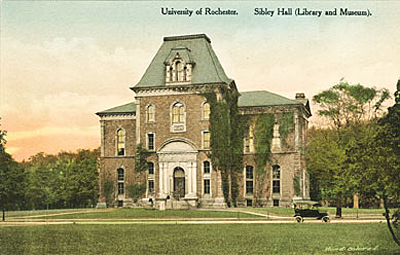
| Prince Street Campus | Sibley Hall |
 |
| Sibley Hall (from old postcard, date unknown) |
| Pictures of
Sibley Hall |
||||
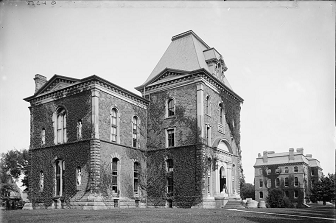 |
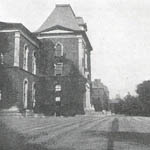 |
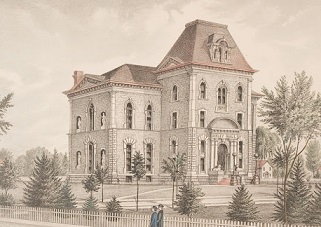 |
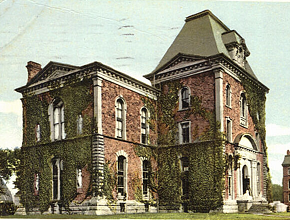 |
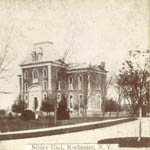 |
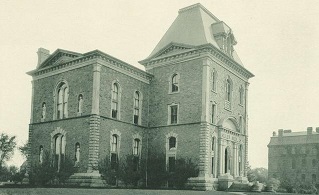 |
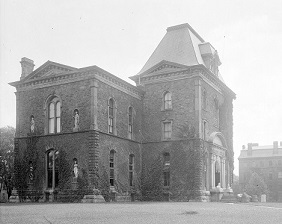 |
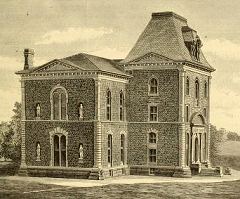 |
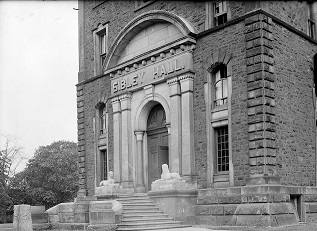 |
 |
Sibley Hall was the gift of Hiram Sibley, a University trustee and one of the founders of the Western Union Telegraph Company. He not only donated the funds for the building, but supervised its construction. It was considered the first "fireproof" structure in Rochester, built with an airspace between the outer limestone walls and the inner brick walls. The beams and staircases were made of iron.
Sibley Hall served as the library and museum of the Prince Street Campus from 1877 until the Women's College departed in 1955. Sibley's son, Hiram W. Sibley, donated a music library that was located in the building from 1905 to 1922 when it was moved to the Eastman School of Music. The music library moved again in 1938 to the new Sibley Music Library building on Swan street. The building was then sold to the Rehabilitation Center of Rochester (now known as the Al Sigl Center) and in 1967 sold to the Red Cross to facilitate expansion of their adjacent office building. The building was demolished in 1968.
Sibley commissioned eight statues to be sculpted in Italy and placed in alcoves on the outside walls of the building. Only six survived the journey: Astronomy, Geography, Science, Industry, Commerce and Navigation. Four of the statutes Astronomy, Geography, Industry, and Navigation were saved and stored by the Memorial Art Gallery when the building was torn down in 1968 and installed on River Campus in 1978 as a 25th reunion gift of the class of 1954. A fifth, Commerce, had been given to English professor James Carley, who displayed it the yard of his home in Toronto. He gave it back to the University in 2013, where she now watches over Florescue von Manstein Plaza between Dewey and Schlegel Halls.
Sibley also donated two sphinxes which flanked the entrance to the building. These were moved to River Campus in 1955 and currently reside outside the doorway to the lower quad entrance between Morey and Lattimore Halls. A bust of Frederick Douglass by Rochester sculptor Johnson M. Mundy was placed in Sibley Hall in 1879 and also moved to River Campus in 1930.
References
1872 "Item on Hiram Sibley's plan for fire proof building on College
Campus," Rochester Union and Advertiser, February 13, 1872, Page
2-1
1877 "College Libraries as Semi-Public Libraries: The Rochester University Library," by Prof. Otis H. Robinson, The Library Journal 2(2):57-60 (October 1877)
1879 "Frederick
Douglass," Democrat and Chronicle, June 17, 1879, Page 4.
Marble Bust of the Great Philanthropist unveiled at Sibley Hall and
formally presented to the city. Sculpted by Johnson M. Mundy.
1881 The
Baptist encyclopaedia, by William Cathcart
Page 1003: Sibley Hall
1884 Encyclopedia
of contemporary biography of New York : illustrated with portraits on
steel, Volume 3, by George H. Bissell
Pages 300-303: Hiram Sibley
1886 "Hon. Hiram Sibley," Scientific American Supplement 21(530):8455-8457 (February 27, 1886)
1888 Hiram Sibley (1807-1888) grave in Mt. Hope Cemetery
1895 A
History of the City of Rochester from the Earliest Times, by
the Rochester Post Express
Pages 135-136: Hiram Sibley
1902 The
Biographical Record of the City of Rochester and Monroe County, New
York
Pages 11-14: Hiram Sibley
1905 "New
Sibley Music Library Complete," Democrat and Chronicle,
January 1, 1905, Page 19.
In Library in Sibley Hall are over 800 works on Music and Scores.
1910 The
University of Rochester : buildings and grounds
Pages 10-14: Sibley Hall
1927 Rochester, the making of a university, by Jesse Leonard Rosenberger, with an introduction by President Rush Rhees.
1933 "Rah for Sibley," by Herman K. Phinney, '77, Rochester Alumni Review 11(3):55-57 | Part 2: 11(4):77-80 |
1955 "UR Starts Moving Books From Women's Campus," Democrat and Chronicle, April 8, 1955, Page 29.
1955 "Sibley Hall, Old UR Library, Sold to Rehabilitation Center," Democrat and Chronicle, December 21, 1955, Page 23.
1967 "A
New Home for Red Cross," Democrat and Chronicle, February
16, 1967, Page 13.
Sibley Hall to be demolished.
1970 University
of Rochester Library Bulletin: The History of the University of
Rochester Libraries--120 Years, by Catherine D. Hayes
Chapter 3: The Sibley Library Building
As the 1860's came to a close, the library was being crowded out of its
one-room quarters in Anderson Hall. Robinson complained of the conditions
in his annual reports and a University committee which examined the
library in July, 1869, recommended that "within a few years a separate and
commodious building" should be erected in which the library could find a
permanent home. Hopes rose in 1870 when President Anderson announced that
Hiram Sibley, a prominent Rochester businessman and a trustee of the
University, would construct a "fireproof" building with the purpose of
creating a library available to the general public.
By Rochester standards in the 1870's, Sibley Hall was a most imposing
structure. It was made of Medina brownstone, capped with a cornice of Ohio
sandstone and a mansard roof. The outside walls were double, with a light
brick wall standing inside and a few inches distant from the heavy outside
stone wall. More window lighting was provided to eliminate the dark
corners, although students later complained that the windows were so dirty
they could see no improvement. On the ground floor, the principal library
room measured forty by 100 feet and rose to a height of twenty-five feet.
Sibley ordered four female statues, symbolizing as many areas of
knowledge, to occupy niches in the exterior walls (to the students, they
were more popularly known as the "bitches in the niches"). Eight statues
were originally imported from Europe, but during the voyage to the States,
four were lost at sea. Sibley also gave two sphinxes to keep watch at the
front of the structure.
It took almost seven years to complete the Sibley library building, seven
years in which Robinson struggled with the increasing size of his library,
storing more and more of the over 12,000 volumes in utility rooms and the
offices of other professors. His problems with what appeared to be a
voluminous collection probably seemed minor to librarians in the much
older institutions in the country. In approximately the same period,
Harvard had 227,000 volumes; Yale had 95,000; Georgetown had 28,000;
Union, 25,000; Brown, 45,000; and Williams, 27,500 volumes. Yet many of
the principal libraries were just as modest, if not more so, as Rochester.
Trinity had 15,000 volumes; Tufts, 16,000; Wellesley, 10,000; Holy Cross,
12,000; Hobart, 13,000; College of William and Mary, 5,000; and University
of Wisconsin, 9,000.
Finally, in the summer of 1877, the Rochester library collections were
transferred from Anderson Hall to Sibley. In the twelve years that
Robinson remained as librarian, the library accumulated more than 25,000
volumes. Although he attempted to open the library for more hours
(sometimes four) a day, the usual opening was for two and one-half hours.
It was not until 1890 that the library was open as long as five hours a
day, and not until 1900 that a full daily opening was the custom. Although
the library now had relatively more commodious quarters, the
accommodations for patrons could hardly be called comfortable or pleasant.
Visitors to the library complained of gas odors from the lighting fixtures
and more often of the temperature, which averaged fifty-eight degrees
during the winter. However, Rochester for the first time had adequate
facilities for its library operations, and President Anderson thought he
had good reason to describe the library as "one of the best organized
libraries connected with any college."
1977 History
of the University of Rochester, by Arthur J. May (on-line
version with footnotes)
Chapter 8, Continuity and Growth
Needs of a different sort were met by the erection of Sibley Hall to
contain the library and (in time) the Ward Museum. In 1868 a faculty
committee was appointed to devise plans for such a structure, and the same
year Sibley became a trustee. At Commencement in 1871 it was revealed that
Sibley--hailed as a "present-day Maecenas"--would finance the cost of a
building, and on May 29, 1872, the donor, shovel in hand, broke ground on
a plot to the west of Anderson Hall. The final plan was chosen by
competition; the winner, a Rochester architect, John R. Thomas, designed
the structure, in the shape of a Greek cross, two stories in height,
though so constructed that if desired two more floors could be inserted.
The building, made of Medina brownstone trimmed with white, would be
capped with a cornice of Ohio sandstone and a mansard roof. On the ground
floor, the principal library room would measure forty by a hundred feet
and rise to height of twenty-five feet; galleries would surround it; on
the floor above, the main area for the museum would have similar
dimensions. A Rochester newspaper described the projected Hall as "the
best planned and designed building of the kind on this side of the
Atlantic."
Construction proceeded at a slow pace, for one reason because Sibley
believed that foundations and the walls of each floor should settle firmly
before another story was put in place. The donor personally hired the
workmen for excavation, masonry and carpentry jobs, and made daily visits
to supervise what was being done. When he decided that the windows planned
for the north and south sides would not furnish, sufficient light, he
ordered that they should be extended by six inches. Limestone used in the
cellar walls and in the upper stories, behind the facing of brownstone,
was dug from Sibley's own quarries a few blocks distant from the Campus.
An air-space of some five inches was left between the limestone and an
inner screen of brick, so that the entire wall was about three feet thick.
The first "fireproof" structure to be erected in Rochester, Sibley Hall
had beams and staircases of iron; only the floors, laid on sand over brick
arches, were made of wood. A panel in the arch over the entrance contained
the date "1874", though in fact construction proceeded from 1872 to 1876,
and grading and other finishing touches were not completed for several
years more. From Italy, Sibley shipped to Rochester eight female statues,
symbolizing as many areas of knowledge, to occupy niches in the exterior
walls, which was interpreted in some quarters as indicative of his views
on coeducation, and he also gave two sphinxes to keep watch and ward at
the front of the structure.
On June 28, 1876, the dedication of Sibley Hall took place, Rossiter
Johnson, 1863, reading a poem, and the annual class day exercises and
alumni dinner were held in the building. It was not, however, until the
summer of the next year that the book collections were transferred from
Anderson Hall, and along with them came a desk at which books were charged
out, which is believed to have done service in the original home of the
college, and the desk of the librarian. (A section of the former library
quarters in Anderson was set aside as a reading room with newspapers and
magazines.)
Assisting in the job of removal was Herman K. Phinney, 1877, who filled
the office of assistant librarian from 1880 to 1930, and he, probably more
than anyone else, collected and preserved materials pertinent to the early
history of the U. of R. At the end of nearly forty years service, the
librarian described Phinney as a mixture of information and
misinformation, not at all quarrelsome, but long-winded and devious, he
had made himself a veritable mine of information not only on the library
and the college, but on the city of Rochester as well. Phinney was
regarded as "a good reference tool," but experience dictated that he
should not be consulted if the desired information could be secured from
any other source.
In the Interpres of 1878 an engraving of the new hall appeared
under the caption "Sibley - $150,000" (which was something of an
exaggeration), standing hard by Anderson's "Scholars to Order Factory."
Undergraduates of later generations sang the praises of "Sibley Hall," to
the tune of "Clementine:"
Placed in the hall (1879) was a much admired bust of Frederick A.
Douglass, Negro antislavery lecturer and journalist, who, for a time
resided in Rochester. In 1968 when the men's dining center was named the
Frederick Douglass Building in honor of the great Negro leader, the bust,
after varied vicissitudes, was put on display there. For a brief period a
collection of paintings owned by Hiram Sibley were exhibited on the second
floor, but they were removed in 1881 to make room for the Ward museum.
It was estimated that Sibley Hall could house 90,000 volumes, or
substantially more than seven times the size of the library when the
building was first occupied. Gifts of books from the estate of Professor
Dewey, from Hiram Sibley, and from alumni enhanced the resources, but only
about $200 a year were allocated to purchases until the income from the
Rathbone fund, mentioned earlier, became available. The Rochester
public--or at any rate "all well-behaved persons"--was welcome to read in
the library, but borrowing of books was restricted to college personnel.
1980 "New Home for Old Sculptures," Democrat and Chronicle, September 15, 1980, Page 1C. | part 2 |
Hiram Sibley Wikipedia page
© 2021 Morris A. Pierce